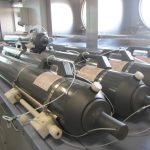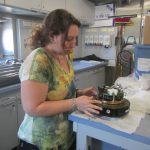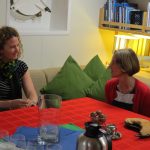The second leg of the TTIDE cruises is set to take off from Hobart on the RV Falkor. We have been busily prepping our instruments, eager to get underway. A two-day delay in port, due to an electrical backup system that needs repairing, has given us a good amount of time to prepare for the big seas and big science ahead!
Our main method of sampling on the RV Falkor will be using the shipboard CTD and ADCPs. On the CTD, we’ve attached two additional ADCPs, which are capable of measuring current velocity as we profile to the bottom of the ocean. Our CTD has also been equipped with chi-pods, instruments that have been developed at Oregon State University, which will give profiles of turbulence from the surface to the bottom of the ocean. Pete Strutton and Danielle Mitchell have been busily setting up the “wetlab” on the Falkor, getting ready to sample the amount of biological productivity within this internal wave beam. In addition to helping us with equipment preparations, Dmitry Brazhnikov is setting up numerical model runs on the supercomputer Nebula onboard the RV Falkor.
Since our group is tasked with determining what the internal tide beam looks like offshore of Tasmania (the “before” picture in terms of the life cycle of this big internal wave), we need to get profiles of velocity, density, turbulence and nutrients throughout the whole water column. From there, we can figure out how wide the internal tide beam is, how much it varies, how strong it is before it reaches the Tasman slope and how much productivity changes inside this internal wave beam.
The TTIDE Leg1 group on the RV Revelle has been furiously deploying moorings on the slope, and we hope to meet up with them in a few days to conduct synchronized sampling on the continental slope before heading to deeper water. Although the weather has been rough and the winds high, they have already started doing important sampling with their CTD. We have been coordinating science plans with them while we wait in Hobart, and we can’t wait to see them out there!
Our team, which consists of a great group of scientists from the USA, Canada, Australia, Germany and Russia, has already started working on other aspects of our cruise. Hayley Dosser and Dmitry chatted with two middle school groups from Los Alamos and San Diego, giving them a tour of the ship and explaining how we do our science. We can’t wait to talk to them again! Pete, Captain Heiko and I also had the pleasure of meeting with the Governor of Tasmania a few days ago along with Mike Coffin from IMAS.
With recent science articles out this week reporting that 2014 was the warmest year on record, it really makes our science come into perspective on how we really need to get out there and get the best observations possible. With everyone’s expertise and knowledge, I know we will have a great cruise filled with amazing science and discovery!
– Amy Waterhouse, RV Falkor
- Niskin bottles waiting to be put on the CTD cage. Credit: Judy Lemus
- Gabriela Pilo prepping ADCPs for deployment. Credit: Judy Lemus
- Sam Kelly and Gabriela Pilo lost in the CTD cage while attaching batteries to power the ADCPs. Credit: Judy Lemus
- Dmitry Brazhnikov, Amy Waterhouse, Spencer Kawamoto and Sam Kelly calibrating the ADCPs on the dock. Credit: Judy Lemus
- Hayley Dosser and Dmitry Brazhnikov chatting with Los Alamos and San Diego middle school groups. Credit: Amy Waterhouse
- Amy Waterhouse meeting with Her Excellency Professor the Honourable Kate Warner on the RV Falkor. Credit: Craig Macaulay
The Tasman Tidal Dissipation Experiment // Supported by the National Science Foundation






